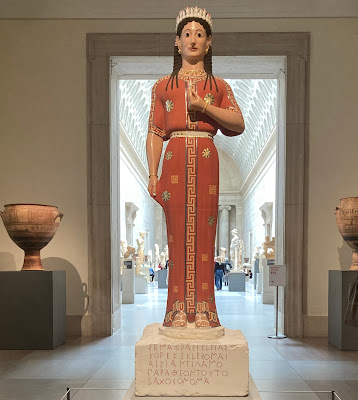The exhibit featured reconstructions of ancient sculptures painted in vibrant colors as they were created 2,000+ years ago. Although sculptures created during the Renaissance were monochromatic and true to how we see them today, it’s important to keep in mind when walking through a museum browsing ancient sculptures the diversity of their appearances in antiquity. According to an essay published by the MET, “Greek and Roman sculpture was originally richly embellished with colorful painting, gilding, silvering, and inlay. Such polychromy, which was integral to the meaning and immediacy of such works, survives today only in fragmentary condition.”
Through modern technology, scientists can collect traces of the actual color from ancient sculptures and use that in reconstructions. The results are stunning. Not only were there reconstructions of marble sculptures in the MET exhibit but also bronzes. Imagine seeing the Riace bronzes in all of their original splendor. The exhibit featured how scientists believe the bronzes appeared in antiquity. The details in their eyes and expressions struck me the most. The warriors come to life when presented with those details.
 |
Reconstruction of the bronze statue Terme Boxer from the Quirinal in Rome |
Though the exhibition has ended, the MET has an impressive online collection. If you’re interested in ancient art and sculpture, I highly recommend visiting the online galleries. Click here to check out the MET’s online works. Click below to watch a video by Smart History on the exhibit.
- Jeannine Guilyard

Comments
Post a Comment